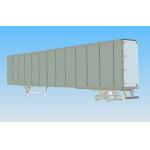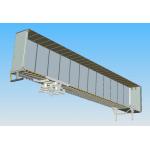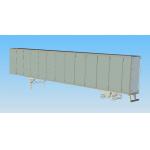Laser Slices Operating Costs
Scanning cuts through test track expenses.
Latest News
January 1, 2007
By Giles Gaskell
A solid model of a 53-foot trailer developed with laser scanning technology will help a leading tier one supplier for automotive, commercial, and off-highway vehicles reduce test track expenses. Validating the ability of trailer components such as axles and suspensions to last hundreds of thousands of miles normally requires multiple iterations of expensive proving-ground testing. The supplier is moving to reduce the amount of testing at the proving grounds by using multibody simulation software, which uses road profile data obtained on the proving ground. It would have taken a designer three to four months to build the solid model of the line haul trailer needed for the simulation. Instead, the supplier saved time and money by contracting with NVision’s service bureau, which was able to model the trailer in just a one month. The virtual trailer will generate test track savings each time it is used.
The supplier is a global leader in the design, engineering, and manufacture of value-added products and systems for automotive, commercial, and off-highway vehicles. It works closely with truck and trailer OEMs and fleets to create products that offer versatility, reliability, and value. Its axles feature a variety of design elements that enhance durability and reduce maintenance.
Trailer components are subject to harsh loads throughout the course of operation. To accurately predict fatigue life, as in rig testing, the entire load-time history needs to be taken into account. The normal approach is for engineers to develop representative load profiles by running a test vehicle on a proving ground under a variety of different conditions. Time histories that indicate the loads seen by the individual components under these conditions are then generated.
 |
| Fully detailed solid model of a trailer. |
The problem with this approach is that long periods of proving-ground driving are required to produce the component-level loads needed as input for either physical testing or fatigue analysis. Outfitting trucks with custom hardware and instrumentation, test set up, running tests, and paying the engineers and technicians to do all of this makes the process costly. The large number of miles needed to ensure realistic results increase product development cycles and costs even further.
Multibody simulation makes it possible to refine the design to a higher level of maturity at an early stage in the development process, which, in turn, reduces time-to-market and uses fewer physical prototypes. This process begins with the creation of a whole vehicle model. Detailed joints, nonlinear forces, state and design variables, auxiliary differential equations, and hydraulics are added in the multibody simulation software. The model can be used to quickly predict dynamic loads and kinematic behavior over a time cycle based on road profiles obtained from proving-ground testing.
Need to Develop Full Trailer Model
The supplier’s project engineer faced the challenge of developing the full vehicle model required as a first step in the virtual proving-ground process. But he knew that the size and complexity of the trailer meant that it would take several months for a designer to create the model from hand measurements and existing 2D drawings. Hand measurement errors, which can be nearly impossible to detect, would affect the accuracy of the simulation adversely. Thus, the engineer turned to laser-scanning technologies that he had used in the past on smaller projects.
Laser scanning systems work by projecting laser light onto surfaces while cameras continuously triangulate the changing distance and profile of the laser as it sweeps along, enabling the object to be replicated accurately. Laser scanners can measure large parts quickly while generating far greater numbers of data points than coordinate measuring machines without templates or fixtures.
 |
| The trailer fully modeled. |
Still, the engineer didn’t feel that he could justify the cost of a laser scanner for the small number of jobs that the company does every year. He had worked with NVision’s Wixom, Michigan, laser-scanning service bureau several times in the past and was happy with the results.
“]NVision] offered the convenience of doing the job right here at our facility,” he said. “They also offered the capability to use a laser tracker, which is the right tool for making accurate large-scale dimensional measurements, and a mechanical digitizer, which is the fastest way to measure points that are relatively close together. NVision made these measurements in single frame of reference and combined the results into a single solid geometry assembly. They were able to complete the job in less time and at a lower cost ]than] my company.”
Laser Scanning and Tracking Saves Time
NVision technicians brought their equipment to the supplier’s Commercial Vehicle Systems headquarters. They mounted targets all over the trailer and used the tripod-mounted laser tracker to measure the distance to each target. They measured not only features but also fine details such as the location of the thousands of rivets that fasten the trailer body to the frame.
 |
| A solid model of the fully detailed trailer. |
The technicians used the laser scanner to generate models of the more complex trailer components, such as the suspension system and the landing gear on the front of the trailer. The technicians also removed the suspension from the trailer and scanned each of the components.
The laser scanner, which was mounted on a mechanical digitizer, was maneuvered around the components in a motion similar to spray painting, capturing the data as it went along. As the technician moved the sensor over the surface of the object, real-time rendering of the data on screen showed the areas that were missed, enabling the technician could fill these areas in with another pass. By operating a single switch and without removing the scanner head, they were able to switch to digitizer mode to pick up points such as hole locations on brackets. The technicians used the same coordinate system for all types of measurements. This made it easy for them to combine the results into a single point cloud in Imageware Surfacer software from which they exported an STL file and then converted to a solid model.
“The model provided by NVision accurately and completely depicted the trailer geometry,” the engineer reports. “It saved us time, money, and effort and is more accurate than what we could have achieved by building the model. We plan to generate the modal neutral file needed to model the trailer as a flexible body in a multibody simulation. Then we will be able to change the suspension components and evaluate the performance and durability of the new design as we perform typical proving-ground maneuvers such as lane changes and Belgian blocks on the computer. While simulation will never replace ground testing, it will greatly reduce the amount that is required by allowing us to evaluate various design concepts on the computer and only test the best design on the proving ground.”
Giles Gaskell is the Director of Business Development for NVision, Inc. Send your comments about this article through e-mail by clicking here. Please reference “Laser Slices Costs” in your message.
Contacts
NVision, Inc.
Southlake, TX
Imageware Surfacer
UGS Corp.
Plano, TX
Subscribe to our FREE magazine, FREE email newsletters or both!
Latest News
About the Author
DE’s editors contribute news and new product announcements to Digital Engineering.
Press releases may be sent to them via [email protected].






